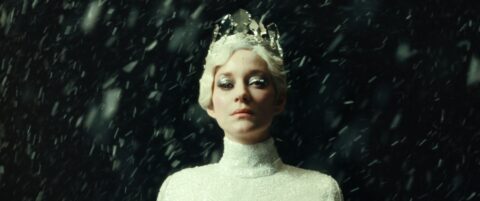Marion Cotillard is one of the last few movie stars. Her imperious presence lends The Ice Tower (Lucile Hadžihalilović, 2025) a sense of forbidding majesty before ever-so-slowly thawing into a deeply human and tragic depiction of power, privilege and abuse.
She is the Snow Queen. Or rather, she is playing the Snow Queen in an adaptation of Hans Christian Andersen’s classic tale in a remote, sad and snowy French town sometime in the 1970s. She stars opposite newcomer Clara Pacini, playing the equally mysterious Jeanne, channeling Sandrine Bonnaire in Vagabond (Agnès Varda, 1985) while looking a little bit like a young Natalie Portman as she runs away from a difficult home situation and stumbles upon an enigmatic movie set.
Spotting her through a slat in the wall, she becomes obsessed with Cotillard’s Cristina, a difficult-to-work-with diva that is all icy surfaces and terrifying beauty. For those who thought Frozen (Jennifer Lee, Chris Buck, 2013) was really a metaphor about lesbianism, The Ice Tower draws more explicit queerness out of the source material. Feminine desire has rarely seemed so fraught with self-loathing.
Taking her precious time to build up to a powerful stealth riff on All About Eve (Joseph L. Mankiewicz, 1950), especially as Jeanne infiltrates herself into the supporting role in the film, Hadžihalilović’s slow cinema style is all about atmosphere, mixing fantasy and reality to (mostly) hypnotic effect.
I say “mostly” because this is an exceptionally slow film. There is an inordinate amount of walking down hallways and through doors, people peering out of windows and mournfully staring at one another. While the lighting is on point with 70s beiges and turquoises, and the soundtrack is suitably aquatic and beguiling with organ and theramin sounds, a solid twenty percent of this film could easily be lost without compromising the overall message or feel. In the wrong mood or without enough coffee, one may get frustrated or fall asleep.
But there’s a lot of purpose here, with the glacial style inextricable from its effect, building a shocking stalactite of sadness one snowflake at a time. Cotillard is particularly adept at mixing haughtiness with humanity, showing the vulnerable woman underneath her seemingly impenetrable exterior. Pacini, inhabiting almost every scene with a muted longing, has the more difficult role, but holds her own well against the Oscar-winning actress. The final result is a deeply sad story as cold as its setting.

Redmond is the editor-in-chief of Journey Into Cinema.
